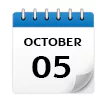5 October 2024 : Indian Express Editorial Analysis
1. Feeling the heat
(Source: Indian Express; Section: The Editorial Page; Page: 12)
| Topic: GS1- Climate Change GS3– Indian Economy |
| Context: |
|
Rising Temperatures and Their Impact on Crop Yields
- Records dating back to the 1950s indicate that India’s average temperatures have been rising, alongside greater temperature volatility.
- The correlation between temperatures and food inflation has also been increasing steadily, especially with a lag effect. As global temperatures rise, crop yields are projected to fall.
- A 2.5-4.9°C increase in temperature could reduce wheat yields by 41-52% and rice yields by 32-40%. Recent heatwaves, such as those in March 2022 and 2024, caused significant crop damage, reducing yields and contributing to high inflation.
- The March 2022 heatwave, for instance, decreased sugarcane yield by 30% and caused similar damage to vegetables and oilseeds.
Decadal Analysis: Correlation Between Temperatures and Food Prices
- The impact of rising temperatures is visible across various crops, both perishable and durable. A decade-long analysis shows that the correlation between average temperatures and food inflation has been growing across major crop categories.
- Perishable crops, such as vegetables and fruits, which are short-cycle crops, are particularly sensitive to heat. Their price correlation with temperature has tripled from 20% to 60% over the past decade.
- Durable crops, such as cereals and pulses, along with animal proteins, have also become more vulnerable to rising temperatures.
- The correlation between temperatures and the price of durable crops has increased fivefold, from 10% to 45%.
Impact Beyond Crops: Animal Mortality and Temperature Sensitivity
- The effects of rising temperatures extend beyond crops. High temperatures can increase animal mortality, which in turn affects the prices of dairy, poultry, and fishery products.
- These prices are also becoming more sensitive to temperature changes. As these trends continue, India’s inflation management strategies must account for both agricultural and livestock vulnerabilities to rising heat.
Reservoirs, Rainfall, and the Role of Temperatures in Inflation Forecasting
- The rising sensitivity of food inflation to temperatures raises an important question: what role do rainfall and reservoirs play?
- While these factors were once considered critical, a detailed analysis of food inflation models shows that temperatures are a far better predictor. In fact, once temperatures are accounted for, the influence of rainfall and reservoir levels diminishes.
- Irrigation improvements and the strong correlation between temperatures and reservoirs (50%) suggest that much of the information captured by reservoir levels is now reflected in temperature data.
Implications for Food Inflation and Rural Demand Outlook
- Looking ahead, the current temperature trends offer some positive news. The transition from El Niño, associated with higher temperatures, to La Niña, which brings cooler temperatures and stronger rainfall, could lead to a drop in food inflation.
- Recent cooling temperatures, after a severe heatwave earlier in the year, indicate that food inflation may fall, potentially bringing headline inflation closer to the Reserve Bank of India’s (RBI) target of 4% by March 2025.
- If this cooling trend continues, the RBI could start easing interest rates in the last quarter of 2024.
Conclusion: Temperatures as a Growing Threat to Inflation Management
- While the normalization of temperatures provides short-term relief, rising temperatures remain a medium- to long-term challenge for inflation management in India.
- Unlike weak rains, which can be mitigated through better irrigation systems, the impact of rising temperatures is harder to manage.
- As temperatures continue to rise, they will likely become a central factor in food inflation forecasting and agricultural policies, requiring innovative solutions to safeguard food production and price stability.
| What are the Major Impacts of Climate Change on the Indian Economy? |
|
Reduced Agricultural Productivity and Yield: Climate change can severely disrupt crop cycles and cause low agricultural yield. Setback to Industrial and Service Sector: There could be an increase in operational costs and a reduction in profits in the industrial sector. Infrastructure Damage: Extreme weather events induced by climate change like floods and heatwaves can significantly damage infrastructure. Labor Market Impacts: Climate induced health hazards could lead to a loss in productivity and cause migration from areas more prone to climate risks. Risks for Banks and Financial Institutions: The RBI classifies risks from climate change into physical risks (extreme weather events, temperature shifts, etc.) and transition risks (credit, market, liquidity, operational, and reputational risks). Impacts on High-Emission Industries: Industries like electricity production, metal products production, transportation, and mining cause maximum greenhouse gas emissions. |
|
PYQ: In the context of India’s preparation for Climate-Smart Agriculture, consider the following statements: (2021) The ‘Climate-Smart Village’ approach in India is a part of a project led by the Climate Change, Agriculture and Food Security (CCAFS), an international research programme. The project of CCAFS is carried out under Consultative Group on International Agricultural Research (CGIAR) headquartered in France. The International Crops Research Institute for the Semi-Arid Tropics (ICRISAT) in India is one of the CGIAR’s research centres. Which of the statements given above are correct? (a) 1 and 2 only (b) 2 and 3 only (c) 1 and 3 only (d) 1, 2 and 3 Ans: (d) |
| Practice Question: With rising temperatures becoming a significant factor in India’s food inflation, discuss the implications of climate change on agricultural production and inflation management. How can India mitigate the challenges posed by rising temperatures on food security and price stability? (250 words/15 m) |
2. Plugging the global skill gap
(Source: Indian Express; Section: The Ideas Page; Page: 13)
| Topic: GS3 – Indian Economy |
| Context: |
|

What is Circular Migration?
- Circular migration is a repetitive form of migration where individuals move to another place (the destination) for employment opportunities and return to their country of origin when work is not available.
- It involves periodic movement instead of permanent or temporary migration.
How is Circular Migration Different from Other Forms of Migration?
- Circular migration is characterized by temporary residence in the destination, the possibility of multiple entries into the destination country, freedom of movement between the origin and destination countries, legal rights to stay, protection of migrants’ rights, and a healthy demand for temporary labor.
The Brain Drain Debate: Permanent vs Circular Migration
- Historically, the permanent migration of highly qualified professionals like doctors and engineers to countries such as the U.S. and the U.K. has been viewed as “brain drain.”
- These individuals often benefited from taxpayer-subsidized education in India, but once they settled abroad, their remittances dwindled.
- In contrast, circular migration, as seen with manual workers in the Middle East, benefits both the origin and destination countries. Workers in the Gulf contribute 40% of India’s total remittances, compared to the 32% from high-income professionals in Western nations.
Historical Context: Migration’s Role in Shaping Societies
- Human migration has played a crucial role in shaping cultures and economies worldwide. The colonization of the Americas and Australia allowed European populations to escape poverty and thrive in resource-rich lands.
- In contrast, India, geographically constrained by the Himalayas and oceans, developed by welcoming external influences rather than expanding outward.
- In the modern era, strict border controls have limited mass migration, but skilled migration presents opportunities for India to address global labor shortages.
Demographic Shifts: The Opportunity for India
- The aging populations in Western Europe and Japan create an unprecedented opportunity for skilled Indian workers. With growing demand for professionals in fields like quantum computing, healthcare, and infrastructure, countries are increasingly looking to developing nations like India for talent.
- Circular migration offers a “win-win” solution, with bilateral agreements ensuring the protection of migrant workers’ wages and social security while guaranteeing their return to India with enhanced skills.
Overcoming Challenges: Skill Matching and Legal Compliance
- Despite India’s vast labor pool, fulfilling global skill gaps is no easy task. Language barriers and the need for specific skill sets are major obstacles.
- Government-to-government agreements require exact skill matching and compliance with the legal requirements of the destination country.
- In response, organizations like the National Skill Development Corporation (NSDC) have aggregated global skill demands and worked with state bodies to prepare workers for international placements.
Maharashtra’s Approach: Preparing Workers for Global Markets
- In Maharashtra, a coordinated effort involving the NSDC, the Maharashtra Institution for Transformation (MITRA), and the state’s Labour and Skill departments has paved the way for the selection of workers for Israel.
- Identifying youth with the necessary skills, providing booster training, and addressing logistical challenges such as passport issuance have been key components of this initiative.
- For instance, specialized training centers were set up to match Israeli standards, and equipment not typically used in India, like bar bending machines, were fabricated locally.
Skill Enhancement and Economic Benefits of Circular Migration
- The selected workers, upon returning after five years, will bring back valuable experience in advanced construction techniques and management practices, which will benefit India’s construction industry.
- MITRA is working to create a dynamic database of skilled youth to meet the future demands of partner countries.
- The initiative also includes language training in Japanese, German, and French to further enhance workers’ employability abroad.
Conclusion: India as a Global Source of Human Capital
- As global skill deficits grow due to aging populations in developed countries, India is well-positioned to become a leading source of human capital.
- Circular migration agreements not only provide immediate economic benefits but also ensure that the skills and experience gained by Indian workers abroad are reinvested in the domestic economy.
- This model represents a sustainable solution to the challenges of global migration, benefiting both the sending and receiving countries.
| Challenges |
|
Exploitation and Unsafe Conditions: Migrants, especially in southern States, often find themselves vulnerable to exploitation by middlemen or brokers. They may be subjected to unhygienic and unsafe working conditions, often without protective equipment. Language Barriers: Language differences pose a significant obstacle for migrants, particularly when migrating to regions where the local language differs from their native tongue. Resentment and Wage Disputes: Indigenous wage groups and labor unions may resent circular migrants, viewing them as competitors willing to work for lower wages. This can lead to wage disputes and conflicts. Subsistence Migration: Many circular migrants engage in subsistence-level employment, with limited opportunities for savings or asset creation. Jobs are often seasonal and irregular, contributing to economic precarity. Return Migration during Crises: The COVID-19 pandemic highlighted the vulnerability of circular migrants. When a lockdown was imposed in 2020, many migrants embarked on long journeys back to their hometowns due to the lack of job opportunities in the host States. |
| PYQ: Discuss the changes in the trends of labour migration within and outside India in the last four decades. (200 words/12.5m) (UPSC CSE (M) GS-1 2015) |
| Practice Question: Discuss the significance of circular migration in addressing global skill shortages and its potential benefits for India’s economy and workforce development. How can government-to-government agreements enhance this process? (250 words/15 m) |



